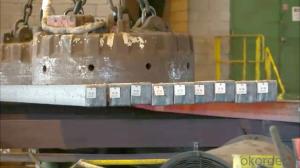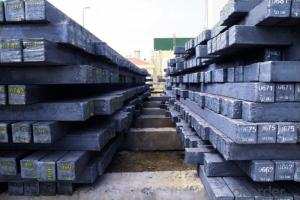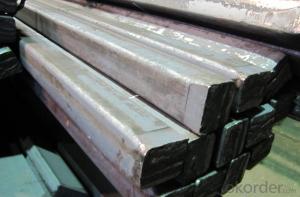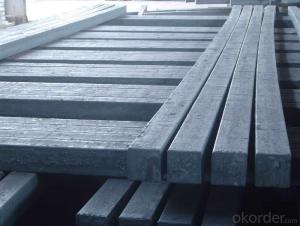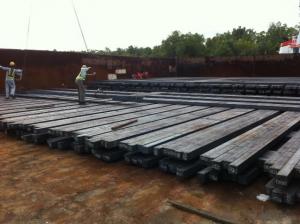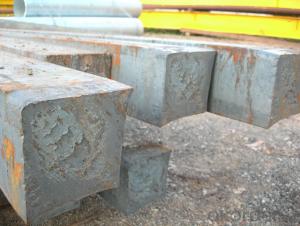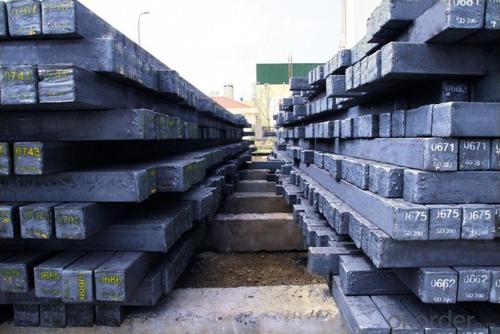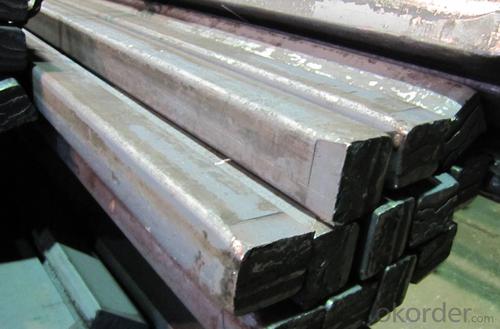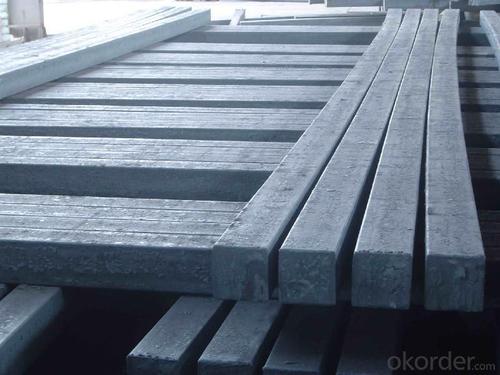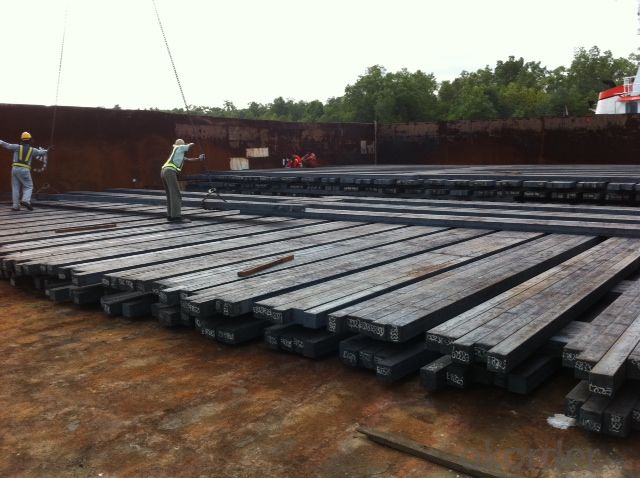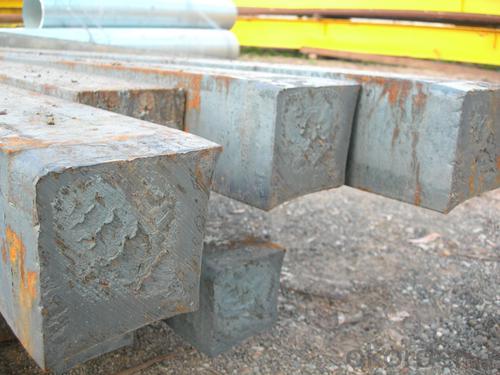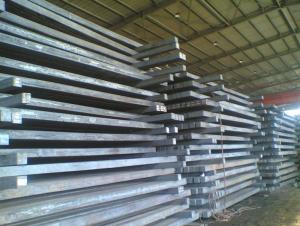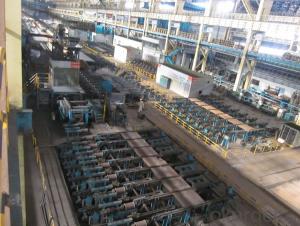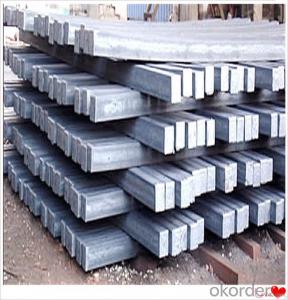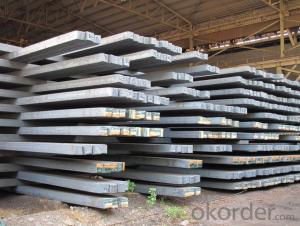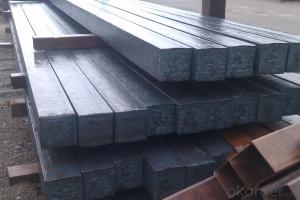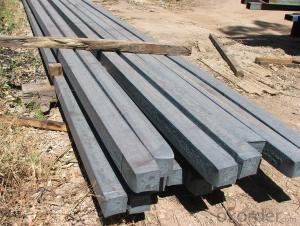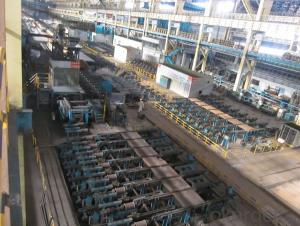Prime Q275 145mm Square Alloy Steel Billet
- Loading Port:
- Shanghai
- Payment Terms:
- TT OR LC
- Min Order Qty:
- 100 m.t.
- Supply Capability:
- 10000 m.t./month
OKorder Service Pledge
OKorder Financial Service
You Might Also Like
Structure of Prime Q275 145mm Square Alloy Steel Billet
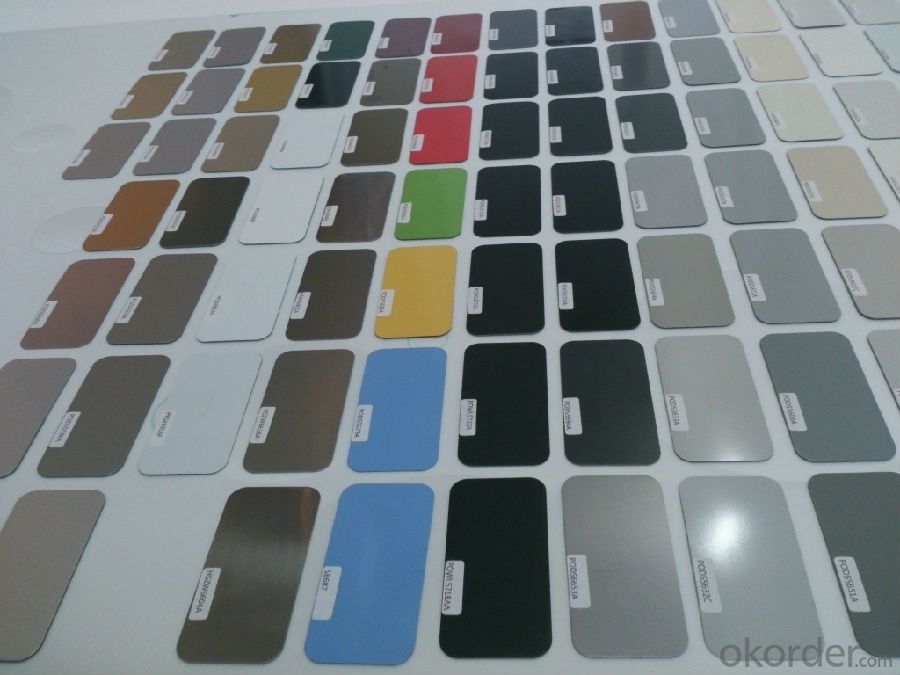
Description of Prime Q275 145mm Square Alloy Steel Billet
1. Prepainted steel coil is coated with organic layer, which provides higher anti-corrosion property and a longer lifespan than that of galvanized or galvalume steel sheets.
2. The base metals for prepainted steel coil consist of cold rolled, HDGI Steel, electro-galvanized and hot-dip alu-zinc coated steel. The finish coats of prepainted steel coil can be classified into groups as follows: polyester, silicon modified polyesters, polyvinylidene fluoride, high-durability polyester, etc.
3. The production process has evolved from one-coating-and-one-baking to double-coating-and-double-baking, and even three-coating-and-three-baking.
4. The color of the prepainted steel coil has a very wide selection, like orange, cream-colored, dark sky blue, sea blue, bright red, brick red, ivory white, porcelain blue, etc.
5. The prepainted steel coils can also be classified into groups by their surface textures, namely regular prepainted sheets, embossed sheets and printed sheets.

Main Feature of Prime Q275 145mm Square Alloy Steel Billet
They were one of several reasons for the wind to be taken out of the sails of the recent oil price momentum. Kuwait’s oil minister said that his country would only commit to a production freeze if all major producers are involved, including Iran. We also had Goldman telling us that oil markets will not rebalance at $40/bbl as it throws a lifeline to cash-strapped US producers.
If it is talk of a production freeze that is behind the rally it shows how low expectations have fallen. It is in the nature of oil people to talk the market up. Any bullish crumb is given exaggerated significance and any port in a storm will do. It is all but fact that the oil market will be tighter in the second half of this year when seasonal demand shoots up and US production continues to decline. It was the same picture last year. If OPEC and key non-OPEC production is frozen that will ensure the daily surplus will fall, but in all likelihood there will still be a surplus and there is an enormous global stockbuild to burn off.
Applications of Prime Q275 145mm Square Alloy Steel Billet
A. Corrugated design makes it excellent waterproof performance
B. Materials as prepainted steel sheets, galvanized steel sheets, galvalume (Al-Zn coated sheets) are available to make corrugated sheet.
C.Those material are durable, anti-corrosion in bad weather for 20-30 years based on it's Zinc(Galvanized) coating or AZ (Galvalume) coating.
D. Different shape of the sheet make it suitable for any style of buildings.
E.Easy to install, no need special tools to fix the sheet.
F.Light weight due to high strength to weight ratio of steel. Light weight means easier handling lower shipping costs, easier installation
G. Different color is availbe base on the RAL Standard make your building more beautiful.
H. We will provide the best solutions if you don't have a exact idea of the specification you want for the steel sheet based on your weather conditions, engineering structure, construction budget and so on.

Specifications of Prime Q275 145mm Square Alloy Steel Billet
Product | Billet |
Material Grade | SGCC / SGCH / DX51D+AZ, etc |
Thickness | 0.6-3.0mm |
Width | 500-1500mm |
Tolerance | Thickness: +/-0.02mm , Width:+/-2mm |
Zinc-coating | Z30-150g/m2 |
Technique | Raw material: Hot rolled steel coil --> Cold rolled_>hot dipped galvalume |
Surface | Dried, Chromated, Unoiled |
Spangle | Regular spangle , small spangle, zero spangle |
ID | 508MM 610MM |
Coil weight | 1-25MT |
Export package | Cardboard inner sleeves, Waterproof paper, galvanized steel covered and steel strip packed |
FAQ of Prime Q275 145mm Square Alloy Steel Billet
We have organized several common questions for our clients,may help you sincerely:
1. How Can I Visit There?
Our company is located in Tianjin City, China, near Beijing. You can fly to Tianjin Airport Directly. All our clients, from home or aboard, are warmly welcome to visit us!
2. How Can I Get Some Sample?
We are honored to offer you sample.
- Q: Can steel billets be used in the production of construction machinery?
- Yes, steel billets can be used in the production of construction machinery. Steel billets are semi-finished steel products that can be further processed into various shapes and sizes, including the components used in construction machinery. These billets can be hot-rolled or cold-rolled to form different types of steel products, such as bars, rods, plates, or sheets, which are commonly used in the construction industry. The high strength and durability of steel make it an ideal material for construction machinery as it can withstand heavy loads, resist corrosion, and provide structural integrity. Therefore, steel billets serve as a crucial raw material in the manufacturing process of construction machinery.
- Q: What is the typical tensile strength of a steel billet?
- The typical tensile strength of a steel billet can vary depending on the specific grade and composition of the steel. However, in general, steel billets have a tensile strength ranging from 370 to 550 megapascals (MPa). This range is commonly found in low to medium carbon steels used for various applications in industries such as construction, automotive, and manufacturing. It is important to note that higher-grade steels, such as alloy steels, can have significantly higher tensile strengths, exceeding 1000 MPa. Ultimately, the tensile strength of a steel billet is determined by its intended application and the specific requirements of the project.
- Q: How does the quality of steel billets affect the quality of the final product?
- The quality of steel billets plays a critical role in determining the quality of the final steel product. Steel billets are semi-finished products, typically produced through a continuous casting process, which serve as the raw material for various downstream steel products. Firstly, the chemical composition of the steel billets greatly impacts the final product's quality. Steel is an alloy composed primarily of iron and carbon, with the addition of various other elements such as manganese, chromium, nickel, and others. The presence and precise amount of these alloying elements in the billets significantly influence the final steel's properties, including strength, hardness, ductility, and corrosion resistance. Any variation or deviation in the chemical composition of the billets can lead to an undesirable alteration in the final product's characteristics. Secondly, the physical properties of steel billets, such as their size, shape, and internal structure, directly affect the quality of the final steel product. The size and shape of the billets determine the dimensions and geometry of the end product, ensuring proper fit and functionality. Furthermore, the internal structure of billets, including the absence of defects like cracks, voids, or inclusions, is crucial for producing high-quality steel products. Any imperfections present in the billets can propagate and cause failures, reducing the strength and overall quality of the final product. Additionally, the manufacturing process of steel billets also influences the final product's quality. Factors such as cooling rate, casting speed, and temperature control during the continuous casting process can impact the microstructure and overall homogeneity of the billets. Proper process control and optimization are essential to ensure that the billets possess the desired metallurgical properties, such as uniform grain structure and absence of segregation or impurities. Moreover, the quality of steel billets directly impacts the efficiency and cost-effectiveness of subsequent steel processing operations. If the billets have a high degree of dimensional accuracy, it reduces the need for excessive material removal during subsequent machining or shaping processes. This results in higher material yield, reduced waste, and improved overall productivity. In summary, the quality of steel billets significantly influences the quality of the final steel product. The chemical composition, physical properties, and manufacturing process of billets all play crucial roles in determining the end product's characteristics. By ensuring high-quality steel billets, manufacturers can produce steel products that meet stringent industry standards, possess desired mechanical properties, and exhibit superior performance in various applications.
- Q: Refinery carbon 3 is propane, then carbon four carbon five is what name ah?.What are they used for?
- Carbon four is butane, C4H10 carbon five is pentane C5H12
- Q: How do steel billets affect the overall cost of a project?
- Steel billets can significantly impact the overall cost of a project as they serve as the raw material for various steel products. The price and availability of steel billets directly influence the cost of manufacturing steel components, structures, or equipment. Fluctuations in billet prices can affect supply chain costs, transportation expenses, and ultimately impact the total project cost. Additionally, the quality and specifications of steel billets can also affect the efficiency, durability, and performance of the final product, further influencing the overall project cost.
- Q: What are the main factors affecting the surface finish of steel billets?
- The main factors affecting the surface finish of steel billets include the quality and cleanliness of the raw materials used, the temperature and pressure during the production process, the type and condition of the equipment used for processing, and the skill and expertise of the personnel involved in handling and finishing the billets. Additionally, factors such as the presence of impurities, chemicals, or contaminants, as well as the use of lubricants or surface treatments, can also impact the surface finish of steel billets.
- Q: What is the role of steel billets in the manufacturing of hydraulic systems?
- Steel billets are an essential component in the manufacturing of hydraulic systems as they serve as the raw material for various hydraulic components such as cylinders, pistons, valves, and fittings. These billets are used to create the necessary strength and durability required for hydraulic system components to function effectively under high pressure and heavy loads. Steel billets are machined and shaped into the desired form, ensuring the reliability and longevity of hydraulic systems in various industrial applications.
- Q: What are the different types of steel billets available?
- A variety of steel billets are accessible, each possessing its own distinct attributes and applications. Among the most prevalent kinds are: 1. Carbon Steel Billets: Comprised mainly of iron and carbon, with minor traces of other elements, these billets are recognized for their exceptional strength and durability. As a result, they are suitable for a wide range of applications, including construction, automotive manufacturing, and machinery production. 2. Alloy Steel Billets: By adding different alloying elements like chromium, nickel, or manganese to carbon steel, alloy steel billets are formed. This infusion enhances the mechanical properties of the steel, making it more resistant to corrosion, wear, and heat. Consequently, alloy steel billets are commonly employed in the fabrication of tools, gears, and high-strength components. 3. Stainless Steel Billets: These billets contain a minimum chromium content of 10.5%, which imparts excellent corrosion resistance. Consequently, stainless steel billets are extensively utilized in industries such as food processing, chemical manufacturing, and the medical field, where hygiene and rust resistance are of utmost importance. 4. Tool Steel Billets: Specifically engineered for applications necessitating high hardness, wear resistance, and toughness, tool steel billets find frequent use in the production of cutting tools, dies, and molds. This is achieved by incorporating elements like tungsten, vanadium, or molybdenum into carbon steel, resulting in a material capable of enduring extreme conditions. 5. Low Alloy Steel Billets: Containing small quantities (typically less than 5%) of alloying elements, such as manganese, silicon, or copper, these billets offer enhanced strength, toughness, and weldability compared to carbon steel. Consequently, they are well-suited for structural applications in construction and engineering. 6. Microalloyed Steel Billets: Also referred to as HSLA (High-Strength Low-Alloy) steel, microalloyed steel billets contain slight amounts of niobium, vanadium, or titanium. This composition leads to a fine-grained microstructure and enhanced strength, enabling the production of lighter and more efficient structures in industries such as automotive and aerospace. These examples merely scratch the surface of the various steel billets available. Each type possesses unique properties and applications, and selecting the appropriate one depends on the desired characteristics and intended usage of the final product.
- Q: How are steel billets used in the production of wire rods and bars?
- Steel billets are used in the production of wire rods and bars as they serve as the initial raw material. These billets are heated and then rolled or forged into long, slender shapes to create wire rods or bars. The size and shape of the billets determine the final dimensions of the wire rods or bars, which are used in various industries such as construction, automotive, and manufacturing.
- Q: What is the typical fatigue strength of a steel billet?
- The fatigue strength of a steel billet can vary based on factors like its specific steel composition, manufacturing process, and surface treatments utilized. Fatigue strength generally refers to a material's ability to endure repeated loading and unloading cycles without breaking. Compared to other materials, steel typically possesses high fatigue strength due to its strength and durability. However, the precise fatigue strength value can differ considerably depending on the steel grade and intended use. In engineering and industry, fatigue strength is often represented by a stress-life (S-N) curve. This curve depicts the stress level exerted on the steel billet versus the number of cycles required for failure. The curve's shape offers valuable insights into the steel's fatigue behavior. It is crucial to note that determining the fatigue strength of a steel billet usually involves rigorous testing procedures. Fatigue testing machines are employed to subject the material to cyclic loading until failure occurs. These tests assist engineers and manufacturers in establishing safe operating limits for various steel grades and applications. Consequently, without specific details regarding the steel grade, manufacturing process, and other factors, it is not feasible to provide an exact value for the typical fatigue strength of a steel billet. Nevertheless, it is widely acknowledged that steel possesses excellent fatigue resistance and can withstand a significant number of cycles before failure, rendering it a dependable choice for numerous structural and mechanical applications.
Send your message to us
Prime Q275 145mm Square Alloy Steel Billet
- Loading Port:
- Shanghai
- Payment Terms:
- TT OR LC
- Min Order Qty:
- 100 m.t.
- Supply Capability:
- 10000 m.t./month
OKorder Service Pledge
OKorder Financial Service
Similar products
Hot products
Hot Searches
Related keywords
